It’s never been easier to get into 3D printing, with machines of all shapes and sizes and price points making it such that there is something for everyone.
For less than $200, you can pick up a competent and compact machine that’ll easily bring your ideas to life. Likewise, tabletop gamers have it made with high-resolution resin printers capable of making insanely detailed miniatures in minutes. Makers pushed for space can tackle 3D printing, CNC, and laser engraving with just a single machine, and those needing a big printer for larger-than-life projects… you get the idea.
Uncountable avenues exist in 3D printing, and we’ve researched and tested a lot of machines to find you the best 3D printer for specific budgets and needs that you can buy right now.
| Best 3D Printer | Market Price (Approx., USD) | Check Price (Commissions earned) | |
|---|---|---|---|
| Under $1,000 (Filament): Bambu Lab P1S | Fast, connected, and enclosed with robust support and multi-material possibilities | $699 | |
| Under $500 (Filament): Bambu Lab A1 | A quiet, quick, high-quality printer with fast swappable nozzles and multicolor potential | $399 | |
| Under $300 (Filament): Sovol SV06 | Budget workhorse with room to upgrade | $185 | |
| Under $200 (Filament): Creality Ender 3 V3 SE | Quiet and capable low-cost all-rounder | $199 | |
| Premium (Filament): Bambu Lab X1 Carbon | Speed, usability, and next-gen smarts | $1,199 | |
| Dual Extrusion: Bambu Lab A1 + AMS Lite | A fast and fine base 3D printer with four-filament add-on | $559 | |
| Small: Original Prusa Mini+ | Portable, high-quality printing without compromise in this most mini of Prusa machines | From $429 | |
| Mid-Size: Qidi Tech X-Plus 3 | A fast and enclosed Klipper 3D printer with active chamber heating | $609 | |
| Large-Format: Mingda Magician Pro | Auto-bed leveling and a print head skewed to quick printing help you print much bigger for less | $359 | |
| Beginners: Bambu Lab A1 Mini | A small, smart, speedy printer that's ideal for beginners | $299 | |
| Enclosed: Bambu Lab P1S | Fully-enclosed, high-tech smarts and speed | $699 | |
| 3-in-1: Snapmaker Artisan | A stylish desktop machine that offers versatile making with wood and plastic | $2,999 | |
| Toy: Toybox | Cute and colorful, fool-proof printing from vast curated library of toys (including well-known franchises) | $299 | |
| Under $1,000 (Resin): UniFormation GKtwo | User-friendliness and a heated resin vat put this one ahead of the pack | $849 | |
| Under $500 (Resin): Anycubic Photon Mono M5s | An excellent, quick-printing plug-and-play experience | $399 | |
| Under $300 (Resin): Elegoo Mars 4 Ultra | Solid performance with uber high resolution, and the convenience of Wi-Fi to boot | $309* | |
| Under $200 (Resin): Anycubic Photon Mono 2 | High-res low-cost workhorse that's easy to set up and use | $159 | |
| Small (Resin): Elegoo Mars 4 Ultra | Remarkable value, with bleeding edge resolution and Wi-Fi connectivity | $309 | |
| Mid-Size (Resin): Anycubic Photon Mono M5s | Resin-saving smarts with convenient Wi-Fi and app experiences | $399 | |
| Large-Format (Resin): Phrozen Sonic Mega 8K S | A user-friendly giant with pre-calibrated print plate and mess-reducing design touches | $1,500 | |
| Beginners (Resin): Anycubic Photon Mono M5s | High spec and performance with simplified set up and app-based assistance | $399 | |
Best 3D Printers
Here are our recommendations for the best 3D printer of a variety of classes, categories, and features.
Under $1,000 (Filament):
Bambu Lab P1S

What’s Great
- Enclosed volume with temperature regulation
- Fast, high-quality printing & effective cooling
- AMS compatible
Building on the success of its budget P1P offering, the Bambu Lab P1S is arguably the company’s best-value printer, giving you a fully enclosed 256 x 256 x 256 mm build volume, super quick print speeds, an auxiliary cooling fan to maintain stability printing at speed, air filtration unit, and out-of-the-box compatibility with Bambu Lab’s excellent AMS multicolor material station for $699.
It’s an easy recommendation for a lot of different printing situations. For beginners, it’s a streamlined experience that requires little effort or prior knowledge from users to achieve great results. For more experienced makers, it’s a reliable machine that requires little input when you need a high-quality print quickly.
Recent updates to Bambu Lab’s software ecosystem mean it’s now possible to print directly on the machine from the company’s smartphone app, with no computer necessary. The whole process is, in a word, convenient. It’s the closest thing to the 3D printer as a household appliance.

Under $500 (Filament):
Bambu Lab A1
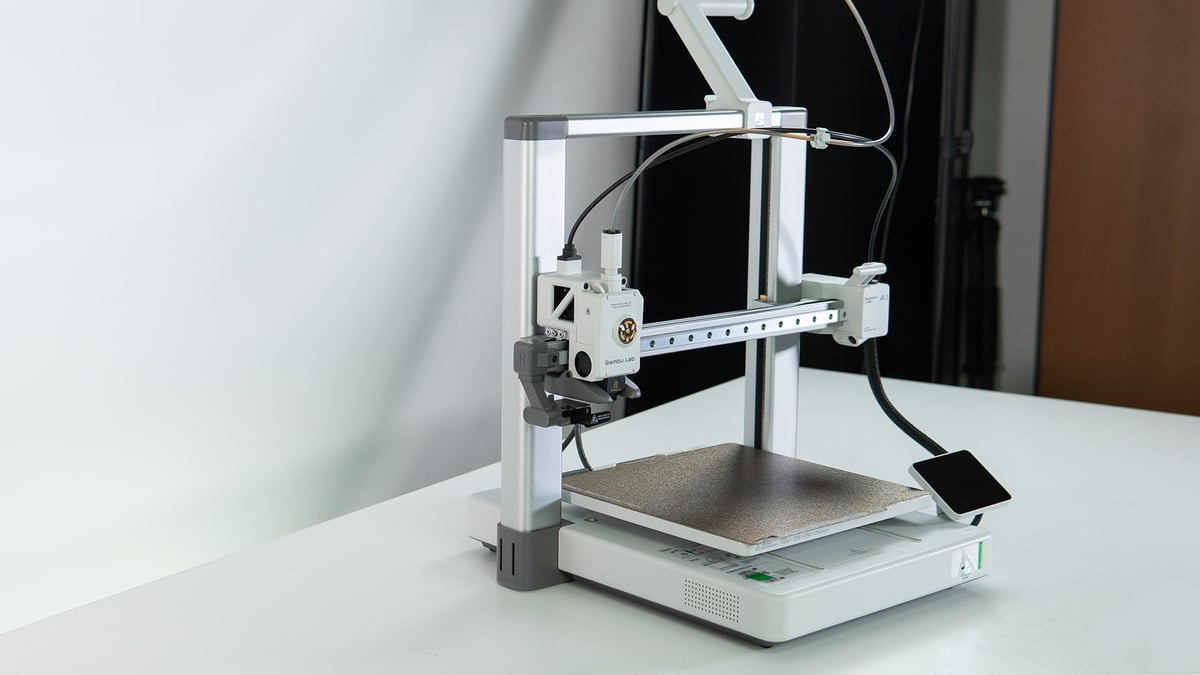
What’s Great
- Quick and quiet printing
- Fully automatic calibration and setup
- Excellent layer uniformity
Note: The Bambu Lab A1 3D printer is temporarily unavailable following a recall action by Bambu Lab. Hit the link to read more.
You can pick up faster CoreXY 3D printers for the A1’s less than $500 price tag, but it’s the ease of use and ecosystem that tip things in the A1’s favor here.
The Bambu Lab A1 is a tightly tuned “standard” sized printer capable of dampening its movements to eliminate the motor noise of printing. The general experience is rich with the mod cons of a 3D printer in 2024, including a nicely designed removable PEI print bed that facilitates easy print removal and snaps back into position with ease. There’s a large full-color touchscreen UI to tap away at and follow through the guided setup, and you’re never left guessing as to what’s happening and where you are.
The A1’s main advantage over similarly-priced systems is its toollessly swappable hot ends. Held in place by a metal cage you can open with one hand. You can drop in a variety of nozzle sizes and toughnesses (all official Bambu Lab products, priced reasonably fairly), making it effortless to scale your printing up or down, from the strength given by chunky layers to high-detail miniatures only possible with a 0.2 mm nozzle.
Lastly, there’s the possibility to add Bambu Lab’s AMS Lite four-filament system, letting you use different colors and materials in the same print. It’s an additional ~$249 purchase (or part of a discounted $559 bundle for both printer and AMS Lite) that seriously augments the printer’s abilities and your options for printing.

Under $300 (Filament):
Sovol SV06
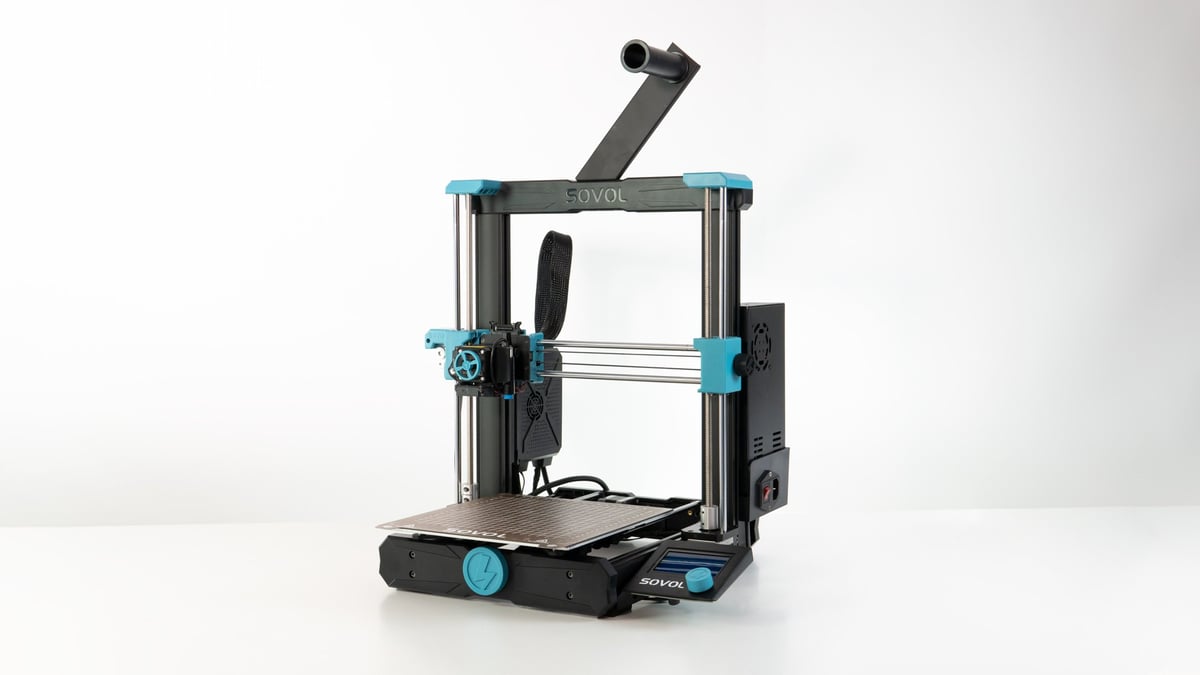
What’s Great
- Excellent performance for the price
- Great removable PEI-coated print bed
- Useful smart features like sensorless homing and auto-bed leveling
The Sovols SV06 made a lot of waves when it launched. The machine is a clone of the ever-popular Original Prusa i3 series but for a fraction of the price. Where Prusa i3 machines can cost as much as $1,099, the SV06 offers similar hardware for just ~$209. That’s not to say the systems are the same (Prusa’s software and quality control are next level), but the SV06 manages to offer a similarly great experience for a very accessible price.
Part of that experience is the SV06’s auto-calibration routines that handle the mesh bed leveling of the 220 x 220 x 250 mm fixed bed with an inductive sensor and level the X-axis that rides on a dual-driven Z – eliminating some of the more tedious maintenance routines. It’s not completely hands-off, though, something newer systems at this price point are starting to offer.
The one thing to watch out for when considering the SV06 is its poor performance with flexible materials. The system’s direct extruder with planetary gearing performs great with rigid filament, but we found flexibles tend to get caught up in the gearing and jam. But, given the all-metal hot end, you can still use more rigid high-temperature filaments than is typical for machines in its price range.
During our review, we also found the SV06’s TMC2209 stepper motors to be remarkably quiet – making for a tidy home printing solution. It’s an excellent machine, suitable for enthusiasts looking for something hassle-free or for beginners who want to tap into the community experience of a popular system.

Under $200 (Filament):
Creality Ender 3 V3 SE
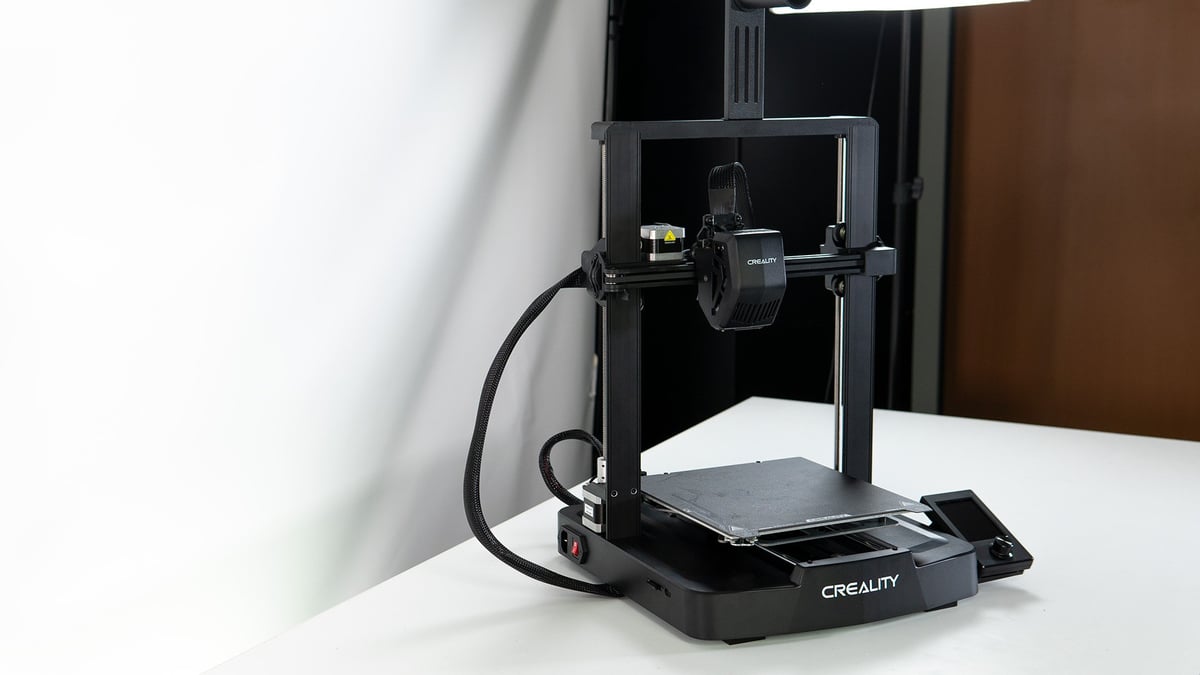
What’s Great
- Reliable auto-bed leveling system
- It’s quiet
- Great bang-for-buck ratio – cheap and capable
The Creality Ender 3 V3 SE sets a new baseline for cheap 3D printing, blending a familiar form with the beginner-friendly fully automatic bed leveling and self-offsetting to give effortlessly perfect first layers.
Its standard features run to a 220 x 220 x 250 mm build volume, with a Sprite dual-gear direct extruder feeding filament to a hot end that tops out at 260°C. Printing through the full height is served by dual Z-axis motors, ensuring stability throughout.
In our time printing with the Ender 3 V3 SE, we’ve found it to be a little workhorse. While it lacks the flashier features and firmware of today’s pricier machines (it runs Marlin firmware out of the box), it offers a fuss-free printing experience that’s a clear evolution on similar machines from previous years.
The removable magnetic print bed can be a bit fussy to return to position after a print, and there’s no filament sensor, which is an odd omission these days, even at this price point. But all in all, a simple yet refined cheap 3D printer.

What’s Great
- Fabulous design and build quality
- High print speeds
- Simple, slick, user-friendly experience
It’s such a subjective thing, premium. But we’ve done our best to define it. Some will say it’s hardware quality above all else, but we think it’s much more. Excellent hardware quality and quality assurance, plus an overall experience that inspires confidence printing and puts less onus on the end user. That’s premium 3D printing to us, and right now, the Bambu Lab X1 Carbon best exemplifies this.
Bambu Lab’s opening salvo of printers, including the X1 Carbon, is a direct hit to the idea that desktop 3D printing for ~$1,000 or less is a dull space overflowing with aluminum extrusions, the tedium of granular settings and conveniences that end at automatic-bed leveling. At the top of the line, the X1 Carbon is available for $1,199.
The X1 Carbon, in addition to using carbon fiber rods in its CoreXY motion system for supreme lightness, sports an all-metal hot end reaching 300 °C plus an abrasive-resistant nozzle and extruder for confident handling of carbon and glass-filled filaments.
Of greater interest, though, is the onboard lidar, which the X1 Carbon uses to scan the print bed and the first layer of a print. If it detects something fishy, it will alert you directly on your computer or via the Bambu Handy app so you can fix the issue before losing time and filament.
Further slickness comes in solid Wi-Fi connectivity (albeit 2.4 GHz only,) a vibrant and responsive touchscreen display, and thoughtful extras, such as the “filament drying” menu option, which walks you through using the X1 Carbon to dry a selected spool of filament using the printers headed print bed and enclosure.
An optional extra, the AMS (Automatic Material System), adds multi-material capabilities supporting four different filaments. It’s possible to chain several AMS units for sixteen-filament prints.
Alternatives
At $699, the Ankermake M5 is what we currently consider the most budget “premium” 3D printer. A bed slinger with a fairly average 235 x 235 x 235 mm build volume, the M5 has a strong direct extruder and a sleek, high-quality frame that discretely houses its more premium features and saves some space. That frame includes a touchscreen display and camera, crucial for the M5’s AI-powered failure detection. The M5 will spot common errors like layer shifting, spaghetti, a blocked nozzle, or prints coming off the bed mid-print and alert you to them. While the system can be hit or miss, AnkerMake is rattling out software updates at a frightening pace. A recent update doubled its already nippy print speed to 500 mm/s
Alternatively, if you’ve got extra cash to spare (prices start at $1,999), the Original Prusa XL could be an intriguing top-drawer choice for you. For one, the XL’s incredibly advanced extruder, dubbed the Nextruder, is loaded with features including a proprietary load cell for “an always-perfect first layer”, print failure, and dirty nozzle detection. It has a large, 360 x 360 x 360 build volume and potential for multiple print (or tool) heads, indicating versatility you don’t find in many other places at this price point.

Learn more
Dual Extrusion:
Bambu Lab A1 + AMS Lite

What’s Great
- Four-filament printing
- Self-calibrating smarts
- lug-and-play
Note: The Bambu Lab A1 3D printer is temporarily unavailable following a recall action by Bambu Lab. Hit the link to read more.
Dual extrusion 3D printing is many things to many makers. We recently broadened it to include multi-extrusion tech, given the sheer versatility such systems offer.
The Bambu Lab A1 is an excellent Cartesian XZ-head 3D printer, and at ~$400, it’s comparatively affordable, too. It boasts a 256 x 256 x 256 mm build volume – just like Bambu Lab’s CoreXY systems – a linear rail across its X-axis for steady and smooth print head motion, and discreet linear rods on all other axes, automatic bed leveling and offsets along with a host of other calibration automation that includes noise reduction, a toollessly replaceable hot end, and the same seamless software experience that made us fast fans of Bambu Lab. Combined with the AMS lite, it’s a four-filament powerhouse for $559.
Like the full-fledged AMS, purging between material changes can be considered excessive. Though that’s one of the reasons the system works as well as it does, it can certainly feel wasteful. There are some more sacrifices when picking the AMS lite over the standard version, too. For one, there are no enclosures for either the printer or the AMS lite, and you’re limited to just four filaments – unlike the full AMS’ extendability to a whopping 16 materials. And, unfortunately, there’s no upgrading later. The A1 series isn’t compatible with the standard AMS.
Alternatives
Tighter budgets can experience dual extrusion with the Geeetech A10M, an Ender 3-style machine that feeds from two extruders into a single nozzle. It’s quite dated now, but at ~$159, we’ve yet to find a printer that offers the same value for dual extrusion 3D printing. Beginners may struggle with it – expect to spend time fine-tuning settings for crisp results.
Alternatively, for a superior four-filament option, consider the Bambu Lab P1S paired with the company’s “AMS” automatic material station. They’re available for $699 and $349 independently, but a bundle currently offers them for $949 together. The printer itself rocks – see above – but with the AMS sitting on top, it can automatically handle up to four different colors or materials for a single print. The unit mounts seamlessly, integrates directly into the printer’s slicer, and outputs high-quality prints. It can be a bit wasteful, though, with seemingly excessive purging between material changes, but this can be managed by adjusting values in the slicer.

Small:
Original Prusa Mini+
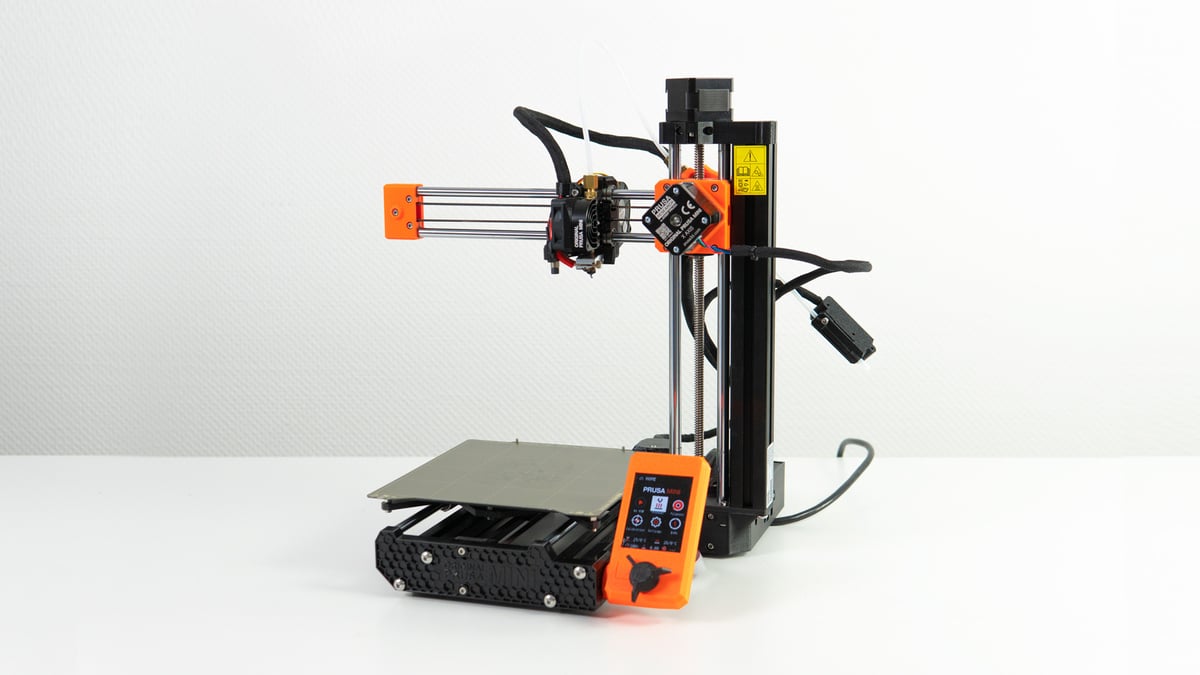
What’s Great
- Good value for the user experience and finish
- Exceptional print quality
- Large, colorful, and easy-to-use UI
Despite its diminutive size, the Original Prusa Mini+ doesn’t hold back. This little printer prints objects of superb quality in a variety of materials, including PLA, ABS, PETG, and even high-temp plastics like PC. Its removable bed makes print handling a cinch, and there’s robust manufacturer support should something go wrong.
The Original Prusa Mini+ benefits from auto-bed leveling through its SuperPinda probe. Dependable and reliable first-layers are a given, just one perk among many on this intelligent little printer.
The Mini+ does not have the smallest footprint of the printers we’ve picked, but it does offer one of the best print-volume-to-size ratios at 12%. The total space it takes up is 457 x 482 x 482 mm – more when you include the printer’s lack of onboard spool holding (arguably the Mini+’s one big oversight). Prusa Research offers a solution in the form of a project to modify the Mini+’s base, accommodating the spool underneath the printer and raising it for a slightly taller overall height. It doesn’t excuse the Mini+’s gangliness, but it does complete the printer if you have the time to tinker.
In 2023, Prusa Research dropped a firmware update that considerably boosts the Mini+’s print speeds, helping the printer maintain some relevance against speedier, newer competition. The printer’s general compactness (and potential for modification to be even more space efficient) is a true asset.
Alternatives
If you’ve got a bigger budget to play with, there’s the LulzBot Taz SideKick 289. Its printing capabilities in standard configuration aren’t much different from the Mini+, but it does have the advantage of being collapsible, with all protruding elements of the printer folding in on themselves with the removal of a few thumbscrews. No tools are needed to set it up, and it all fits within its small, desktop-PC-sized frame. The toolless modularity extends to tooheads, too. You can purchase different extruder setups for different jobs and materials, giving you quick swaps and high productivity. It’s a pricey upgrade, though. A standard configuration with all you need to print out of the box runs around ~$1,085.

Learn more
Mid-Size:
Qidi Tech X-Plus 3
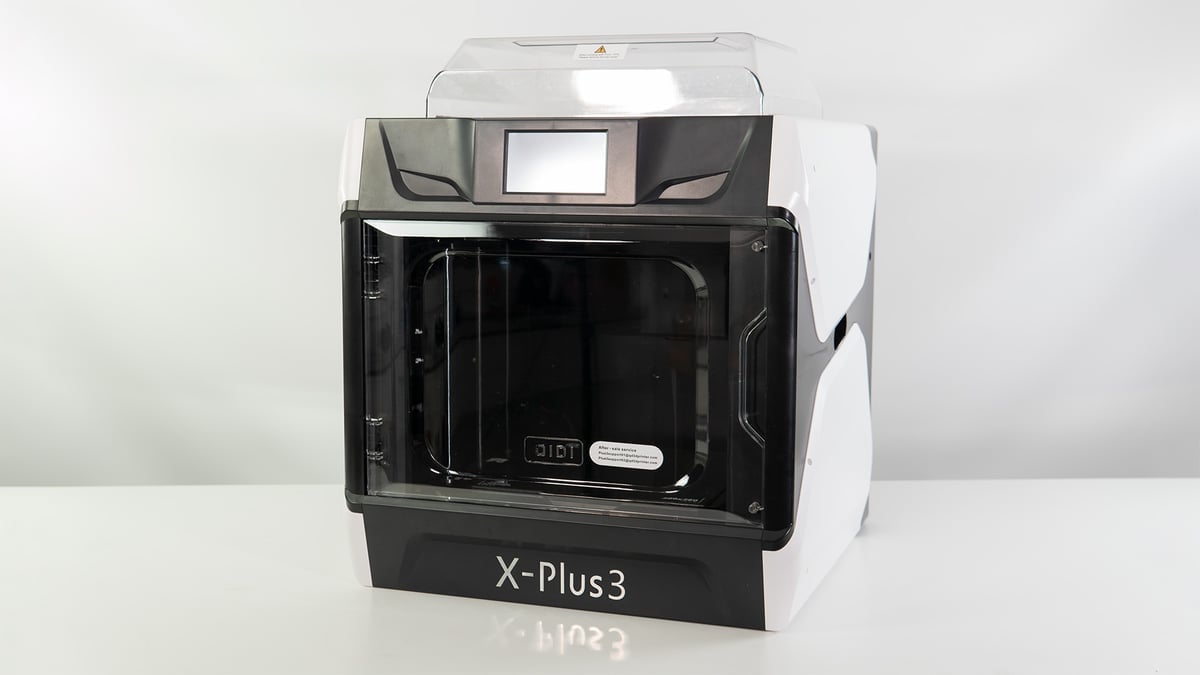
What’s Great
- Fast, high-quality printing
- Actively heated build chamber
- Vanilla Klipper experience
For its ~$600 price tag, the Qidi Tech X-Plus 3 gives you a Klipper-based machine with a fully enclosed 280 x 280 mm build area – the smallest on our mid-size filament 3D printer recommendations, granted, but still in the ballpark of 300 x 300 mm, where we feel “mid-size” begins in desktop 3D printing. It uses a CoreXY motion system and input shaping, allowing it to print up to 600 mm/s in some situations. Speedy acceleration and a high-flow hot end let it put plastic down at a rate that’s on pace with today’s top speed-touting printers.
The X-Plus 3’s party trick is an actively heated build chamber capable of heating to 65 °C. Indeed, this printer is friendly to warp-happy materials, performing favorably against similar-style printers that lack actively heated chambers in testing. A filament dry box is included as standard, mounting to the back of the printer and serving as the default (and fiddly, but still removable) spool holding option.
Compared to many modern enclosed-style printers the X-Plus requires some initial calibration, which is a bit old hat, but we found it to hold its offsets and, generally, it remained a hands-off experience throughout our printing.
Overall, it’s a handily complete package that doesn’t disappoint for the price tag. It’s not the prettiest printer – unless lots of plastic and an overinflated look are your thing, we don’t judge – but it does put down plastic with speed and uniformity, which we absolutely rate it for.
Alternatives
Thanks to an ever-decreasing price tag, the Sovol SV06 Plus, our former top pick for mid-size filament 3D printers, is now our budget pick. For some ~$290, you get a sturdy, upgradeable bed-slinging 3D printer that offers decent print quality from the get-go. TPU performance wasn’t the best – we found the noodly filament tangled easily in the SV06 Plus’ planetary extruder, but the whole thing is easy enough to dismantle and return to functionality.
Those with deeper pockets should look to the Qidi Tech X-Max 3 – basically a larger X-Plus 3 with minor differences. The main thing to know is the build volume increase from the Plus’ 280 x 280 mm build area to a roomier 320 x 320 mm. Everything else about the experience is the same and great. Near vanilla Klipper with Fluidd built into the slicer, plus a heated, enclosed print chamber and fast, uniform prints following a partially manual calibration. As a larger machine, it carries a larger price tag, too – approximately $900 at the time of writing.

Large-Format:
Mingda Magician Pro
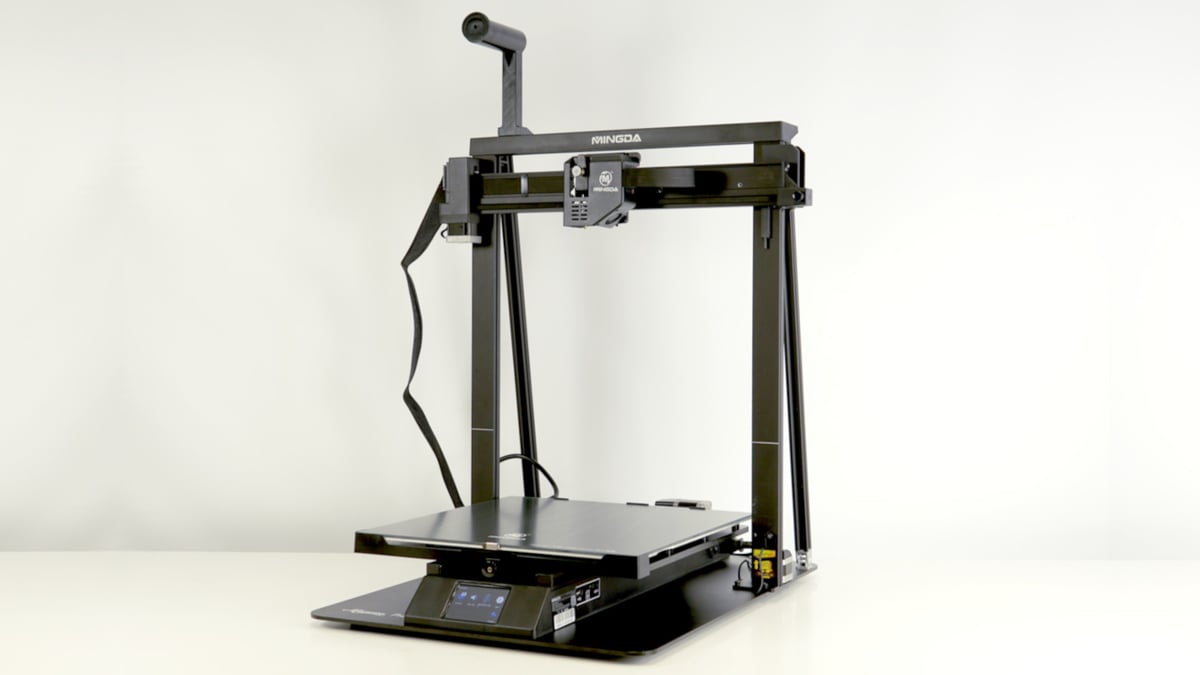
What’s Great
- Easy assembly
- Sturdy construction
- Quiet operation
There are hot new speed-oriented large-scale printers now, and while the Mingda Magician Pro isn’t one of them, the pricing pressure from the newer machines means this former upgrade is terrific value right now.
The Mingda Magician Pro comes with the comforts you’d expect of a pricier printer, including a direct extruder, a simple-to-use touchscreen interface, a full metal base plate, and an excellent 400 x 400 mm textured glass build surface complimenting the 400 mm Z axis.
The large print bed retains heat well and gets suitably hot, even towards the extremes of the build volume, not a given at printers of this size. Mingda’s textured glass worked well with larger prints, though we found in testing that a raft or brim was necessary more often than not for smaller prints.
For a large 3D printer, the Magician Pro is remarkably quiet, which is a plus if you plan on running it in a domestic setting. Not so great is the omission of large-bore nozzles in the box. If you’re planning on printing large models, stepping up a nozzle size or two from the stock 0.4 mm nozzle provided is essential to cut print times down to a reasonable number of hours instead of days.
Alternatives
With prices in flux a little, we don’t really have a clear budget large-format recommendation to point to right now. So, instead, we’ll throw a little curveball and suggest that perhaps a mid-size 3D printer is a fine alternative to save a buck or two. The Sovol SV06 Plus offers a fair balance of performance, build volume and price.
Alternatively, we recently tested a feature-packed Klipper-toting large format 3D printer that comfortably scales up your possibilities. The Comgrow T500 offers a roomy 504 x 504 x 504 mm build volume, wireless connectivity, a tank-like build, and a handy 7-inch touchpad interface with KlipperScreen UI. Large nozzles come in the box, too, expediting your journey to quicker large-scale prints.

Beginners:
Bambu Lab A1 Mini
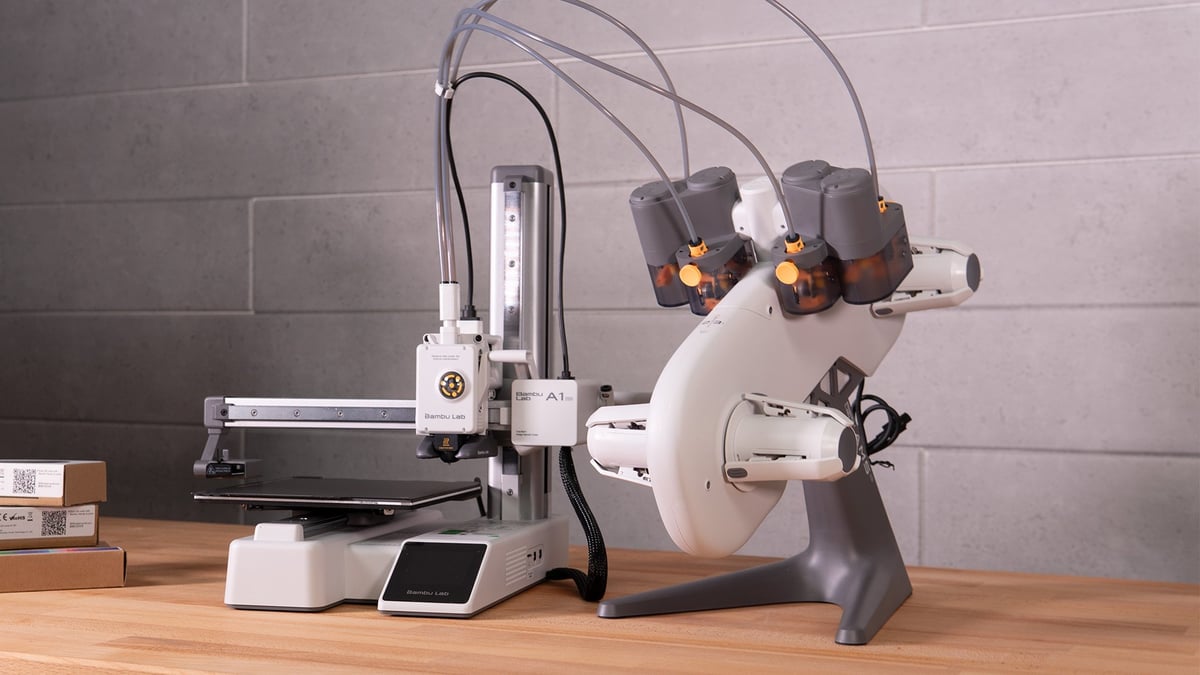
What’s Great
- Fast, with self-calibrating smarts
- High-uniformity prints
- Beginner-friendly experience
The linear rail-touting Bambu Lab A1 Mini is small, with a build volume of just 180 x 180 x 180 mm, but don’t let its size fool you into thinking it’s in any way diminished – it is packed with smarts, including noise-cancelation tech, full self-calibration, over the air updates and self-diagnostics, all for just $299. It’s also fast, and during testing, it consistently delivered impressive quality prints.
The A1 Mini offers, in a word, simplicity and builds upon this with Bambu Lab’s new MakerWorld 3D model repository, which offers one-click printing with the A1 Mini.
We found it’s not quite as polished as the company’s other offerings: the interface is a touch laggy, and there are minor bugs in the UI. Largely, though, these compromises are few and far between and well worth bearing for the savings and variety of quality-of-life features that come with the machine. A high-quality camera for remote monitoring, a (admittedly finicky) nozzle wiper, and – perhaps most importantly – a hot end that allows for toolless swapping, making it trivial to change nozzle sizes for fast or highly detailed prints.
Its printing capabilities are a little narrower than other Bambu Lab printers (you’re more or less confined to PLA, PETG, and TPU-like filament), but your horizons widen somewhat with the A1 Mini’s compatibility with Bambu Lab’s AMS lite, a four-filament system for multicolor and multi-material printing.
All told the Bambu Lab A1 Mini is the ideal beginner 3D printer and a machine that we have recommended to friends getting into the hobby.
Alternatives
For tighter budgets, the Kingroon KP3S 3.0 offers a comparable but more basic experience. Often available for ~$100, you get atypical hardware for the price point, including linear rails, plus an easy upgrade path and an enthusiastic community surrounding it.
Alternatively, if you’re new to 3D printing and have a larger budget to work with, there’s no better value under $1,000 than the Bambu Lab P1P. Besides being one of the quickest printers around, it’s practically plug-and-play, is easy to operate, and has customizable design elements that allow you to truly make your shiny new 3D printer your own.

Learn more
Enclosed:
Bambu Lab P1S

What’s Great
- Excellent software & UI
- Fast, effective printing & cooling
- AMS compatible
For price to function, and performance, the Bambu Lab P1S is the 3D printer to beat. And not just in terms of enclosed 3D printers, the P1S is currently our pick for the best 3D printer under $1,000 overall, too.
The Bambu Lab’s P1S is arguably the company’s best-value printer, giving you a fully enclosed 256 x 256 x 256 mm build volume, a strain gauge array embedded into the build plate for fully automated bed leveling, a built-in light and (admittedly lackluster) camera to see within that volume, super quick print speeds, an auxiliary print fan to help along printing at higher speeds, and out-of-the-box compatibility with Bambu Lab’s excellent (separately purchased) AMS multicolor material station, all for $699. It’s an easy recommendation for a lot of different situations.
Its enclosure rounds out the roster of compatible materials, helping to limit the spread of UFPs and generally increasing your success rate when 3D printing. It also helps the system look tidy and self-contained, which is a plus for home users.
Note that the P1S doesn’t monitor chamber temperature. Temperature regulation is limited to ensuring temperatures don’t fly off the chart, and Bambu Lab still advises opening the door and top cover when printing low-temperature filaments like PLA.
It’s not perfect (no printer is), but the P1S’ tradeoffs are minor. For one, the buttons and UI on the machine are comically poor, but you can just use your computer or smartphone instead. Also, not being able to access the contents of the printer’s microSD memory remotely is frustrating, but that’s common to all Bambu Lab printers, bar the X1.
All told, the Bambu Lab P1S is a powerhouse of a printer at a middle-of-the-road price point.
Alternatives
Slimmer budgets in need of an enclosed 3D printer can experience the speed and print quality of the P1S, with the notable but manageable compromise of a hit to print volume, with the Qidi Tech X-Smart 3. A teeny tiny 175 x 180 x 170 mm build volume machine with CoreXY kinematics, Klipper firmware, and solid, PrusaSlicer-based software, it can be picked up for ~$300. Bargain.
Makers with larger needs of their machine should consider the X-Smart 3’s supersized sibling, the Qidi Tech X-Max 3. Packing a 320 x 320 mm build area, plus similar fast, quality prints, Klipper firmware, and software, the X-Max 3 stands apart not only for its build volume – it has a heated print chamber, improving your print success rate when using warp-happy materials. Such a feature set comes at a price, though: approximately $900.

3-in-1:
Snapmaker Artisan
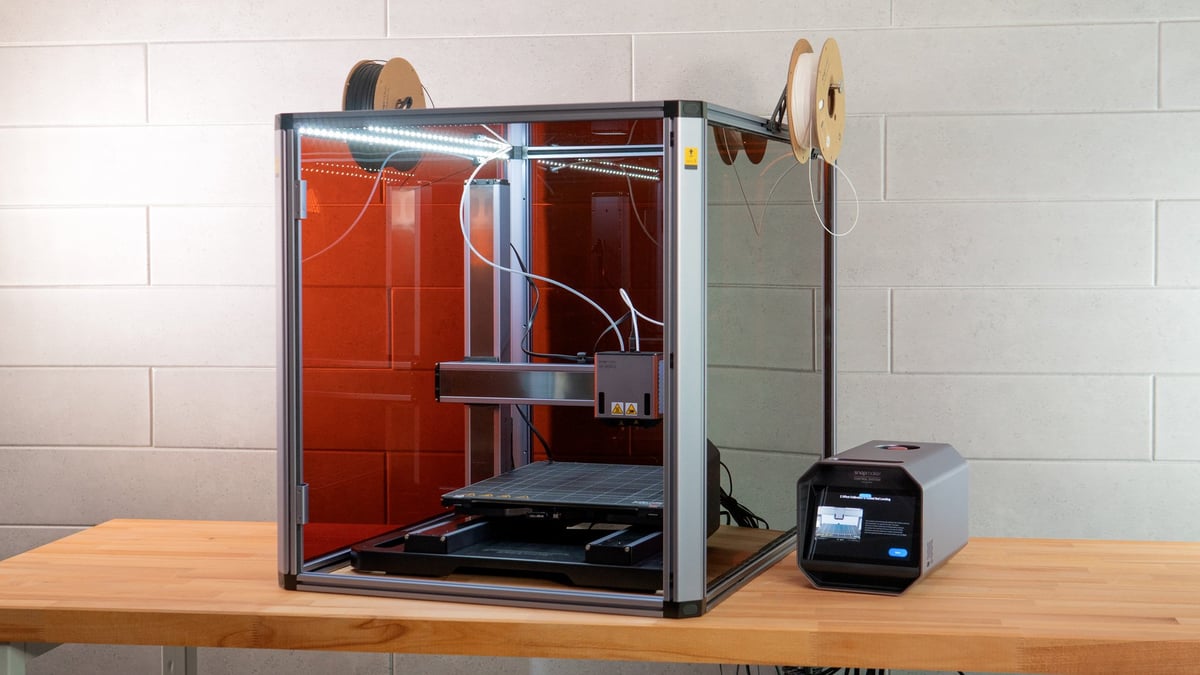
What’s Great
- Three creative tech tools in the footprint of one
- Overall presentation of the Artisan is premium
- Decent dual extrusion printing experience
There’s an unquestionable slickness to the machines Snapmaker produces. High-quality fit and finish backed up with glossy build guides and manuals to inspire your creativity. The Snapmaker Artisan is the latest in this series. At ~$3,000, it’s a considerable markup from its solidity and more versatility with the multitude of creative processes you can tackle.
Separating the Artisan from its predecessors is the perfected quick-swap mechanism, which truly makes changing modes a toolless, effortless procedure. Other improvements see the Artisan operate quicker and quieter than the Snapmaker 2.0.
More powerful laser and CNC modules come as standard, giving a slight spec bump on the 2.0, too. And there’s a nifty dual extrusion experience in the UltiMakeresque print core system, letting you quickly combine different nozzle types in your work.
Of note also is the inclusion of a fast-heating print bed, which has user-selectable zones for faster printing of smaller models.
If you expect to need to swap modes often and really put your machine through its paces, the Artisan is the comfortable choice. While it’s not necessarily better than a dedicated machine for each of the functions it offers, it does a competent enough job of combining the three.
Alternatives
Our old top pick, the Snapmaker 2.0 A350T, still exists and, with new lower pricing (~$1,200), still presents great value for money if space is at a premium and you absolutely need to do some combination of 3D printing, laser engraving, or CNC carving. Out of the box, it’s missing the bells and whistles of the new Snapmaker Artisan, but for close to a third of the price, you’re getting the same basic experience. There is also the possibility of upgrading the 2.0 with more powerful toolheads and peripherals, including the Artisan’s quick-swap module fixtures and powerful lasers with air assist.
Those still limited on space but with bigger budgets should consider the ZMorph Fab. A more-than-3-in-1 multifunction creativity power tool, it offers diverse 3D printing toolheads, including dual extrusion, plus CNC and laser cutting, and thick-paste extrusion. The machine itself is rather beautiful, with sheet metal flares, a tidy UI, and sophisticated software to boot – though you’ll need to part with $5,999 to call one your own.
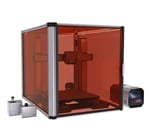
Learn more
Toy:
Toybox
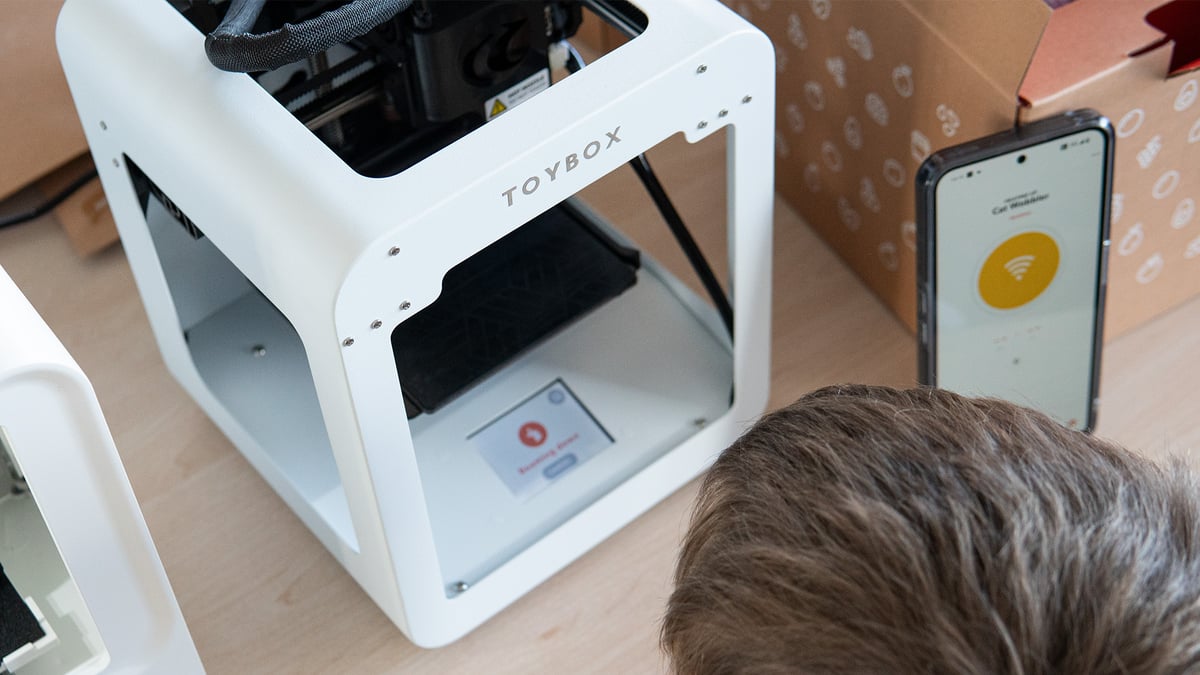
What’s Great
- Massive toy library to print
- Kid-friendly experience
- Snappy on-device UI and app-based control
Critics will point to its premium models and plus subscription as a negative, but much like the shows and movies your kids stream on the likes of Disney+ or Netflix, Toybox’s offering is not an unfamiliar reality of modern media consumption. On the plus side, there are no ads, and the curation here means everything you see is not only possible to print but nearly impossible to mess up. The Toybox takes the effort of finding or making 3D printable toys, for the most part, out of your hands.
The purchase of the printer is enough to give you access to thousands of models and some basic in-app model creation from the get-go, but the 10,000+ library can be expanded through purchasable extras and a monthly subscription. There is plenty here to keep inquisitive young minds going.
Toybox’s greatest success is in cutting the clutter of the process of 3D printing and making every toy a tap away from physical reality. The print quality is not great, not by a long shot, but having put all of the machines tested for our toy 3D printer guide in front of real, live, fidgety kids, they simply did not care how good the prints were or weren’t. What mattered was that going from finding a model in the library to printing it on the Toybox’s dinky print plate is an intuitive and fast process that can keep pace with young kids’ shorter attention spans.
Alternatives
For slightly older kids, or parents looking for a little more agency over the items they print without going full hog into the hobby of 3D printing, the AOSeed X-Maker offers a terrific blend of customizable prints and a more general 3D printing experience. Its app needs a bit of polish, but at its core, it offers a library of ready-to-print models and a suite of tools for kids to customize subsets of toys and props. At closer to ~$500, it’s much pricier than the Toybox, but the printer is more capable.
Alternatively, if you’re looking for a capable printer to augment your kids’ play and are willing to dip your toes into “full” 3D printing (rather than the more walled-off, kid-friendly version outlined above), look to our top pick for beginners, the Bambu Lab A1 Mini. It’s fast, smart, and holds your hand. Furthermore, you can get the full experience of slicing your own models and configuring jobs to print or fire jobs directly to the machine from the companion app. It’s close to the best of all worlds, although greater supervision would be required if using the browsing user-created 3D model websites.

Under $1,000 (Resin):
UniFormation GKtwo
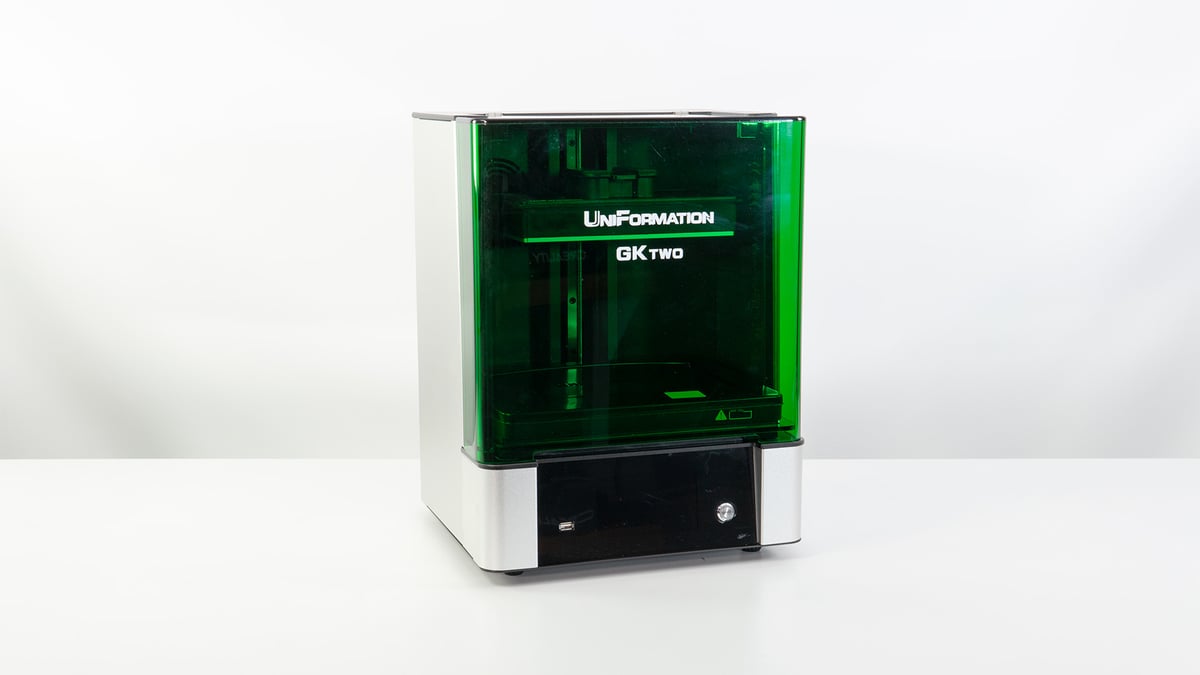
What’s Great
- Smart design – tidy operation
- Heated vat improves success rate
- Hinged lid for easy access
The UniFormation GKtwo is a mid-sized printer with oodles of design touches to make using it a tidier and smoother experience than other low-cost resin 3D printers. It may not offer cutting-edge resolution like the Photon Mono M5s or Mars 4 Ultra featured elsewhere in this list (it’s still an infinitesimal difference to the eye if you ask us), but it offers the luxury of a quick-release print plate and slide-out resin vat, plus a hinged lid for convenient access to the build chamber.
The GKtwo also boasts a killer feature in its temperature-controlled heated resin vat. A crucial component of assured 3D printing success with resin is that the resin temperature is sitting pretty around 30 °C. Prints can work below this, but it’s one heck of a catalyst for reliable performance to have your resin warm. The GKtwo lets you select from one of three temperatures for your resin vat, and the printer will calculate in a heat-up period before your print commences. The entire system is automatic and baked into the printer’s software, making it an effortless print success system.
It produces fabulously crisp prints, thanks to its mid-size 8K masking LCD, and, if your budget can stretch further, it can pair with complementary post-processing stations designed to fit the printer’s build plate. (You can, for example, take the plate straight out of the printer and lower it into a recess in the company’s ultrasonic cleaner for efficient, hands-off cleaning.)
Handily, the GKtwo is supported by popular third-party slicers, including Voxeldance Tango, Lychee, and Chitubox Basic. The provided slicing software is based on PrusaSlicer, which gives excellent support structure generation, so you may well be comfortable sticking with that instead.
A 12K LCD upgrade and Wi-Fi dongle for the GKtwo are due to be released soon, which will put the GKtwo head and shoulders above the rest.

Under $500 (Resin):
Anycubic Photon Mono M5s
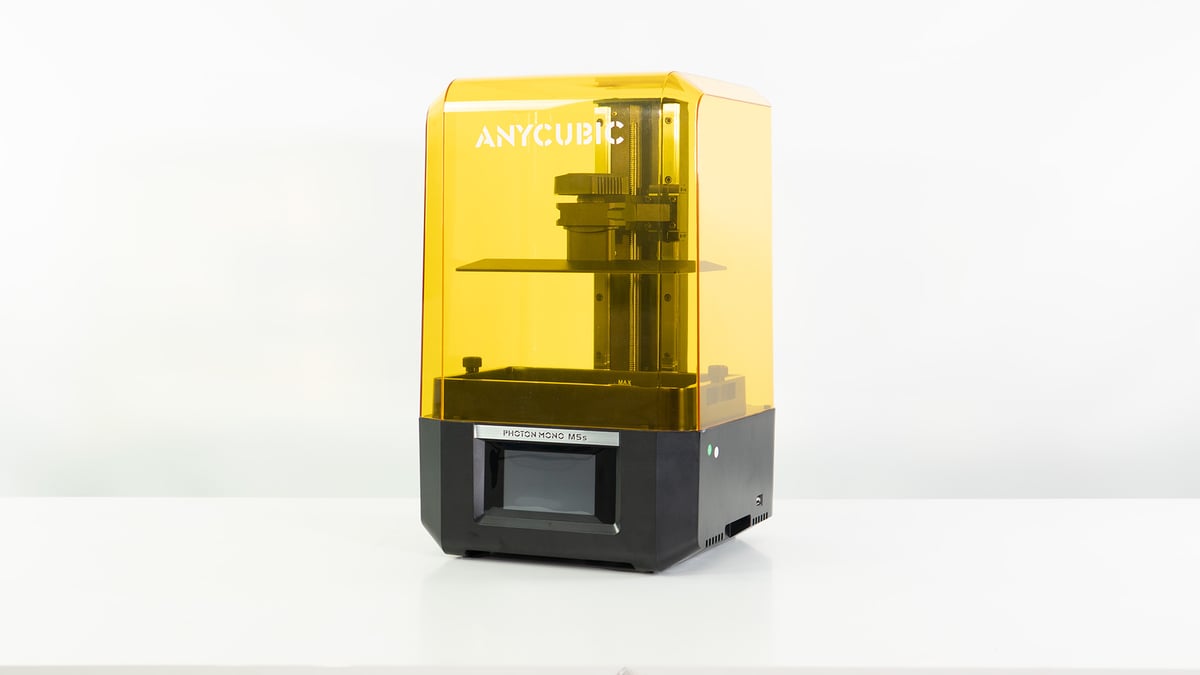
What’s Great
- Capable of fast, high-res printing
- Resin level & print failure smarts
- Well-implemented Wi-Fi connectivity
Anycubic Photon Mono M5s is a different breed of desktop resin printer, introducing print-boosting smarts the likes of which we’ve only really seen in filament 3D printing over the last couple of years. Packing a print-plate gantry-mounted sensor, the M5s can detect peel force, resin level, and the vat bottom to augment your printing experience.
In testing, we didn’t find it to be flawless. Few are. But that this system pulls off even half of what it does makes the M5s our preferred choice over all the other desktop 3D printers we’ve experienced lately.
All of the above is in a compact frame, to boot – the Photon Mono M5s’ dimensions are barely any larger than the likes of the Phrozen Sonic Mini 8K S and Photon Mono 2, both machines we consider to be small 3D printers, yet it punches out with a 200 x 123 x 218 mm build volume.
Print speed is a focus; the M5s comes with ACF film for its resin vat interface layer, allowing for quicker than typical layer changes. It also packs a 12K 10.1-inch masking LCD, which puts extremely small pixels at its disposal for super-fine print resolution. It’s as fine as you can get.
Anycubic has gotten the Wi-Fi connectivity of the printer to sing, with a seamless link between the company’s software and hardware. You can also keep tabs on things using the company’s surprisingly slick mobile app, which gives you diagnostics of the printer, guides, and tips, plus a community aspect with models you can pipe to the print at the click of a button – all without bombarding you with adverts or notifications.
It’s a quick and compact printer with layers of features for its ~$400 price tag – certainly one to consider if you prioritize convenience.

Learn more
Under $300 (Resin):
Elegoo Mars 4 Ultra
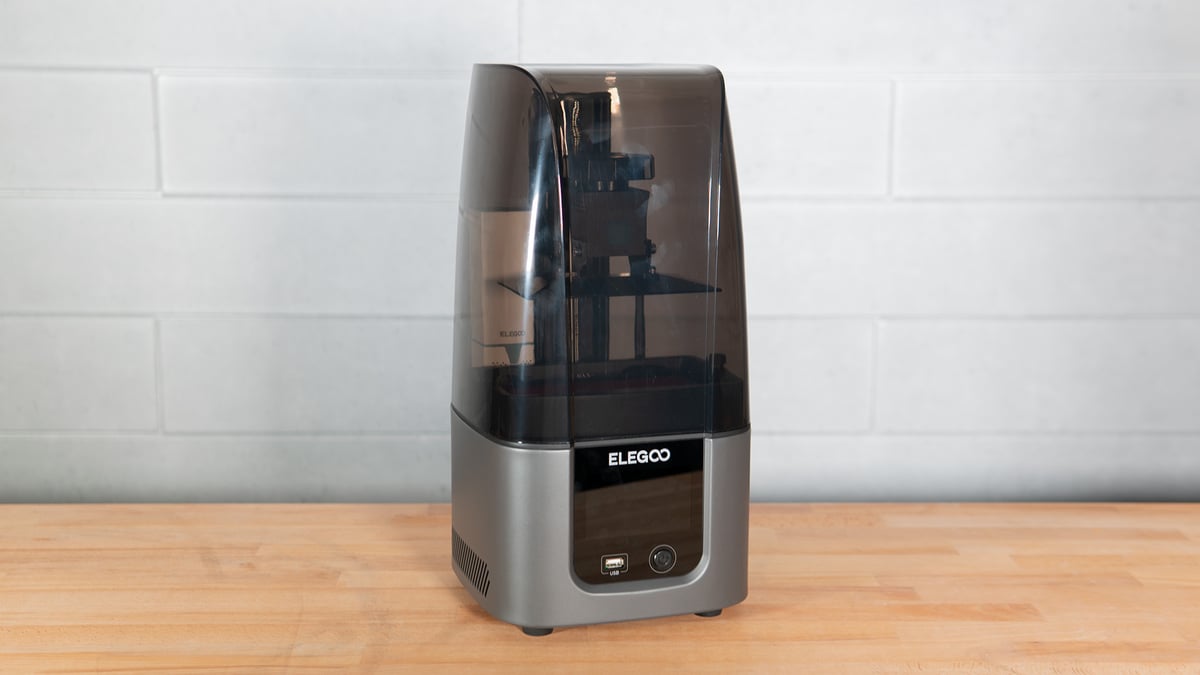
What’s Great
- Bleeding-edge resolution
- Useful Wi-Fi connectivity
- Top all-round performance
In our opinion, as long as it’s still supported and continues to drop in price, the Elegoo Mars 3 is the budget resin 3D printer to beat. But, if your budget stretches closer to $300 than the Mars 3’s sub-$200 price tag, the top-spec variant of its successor, the Elegoo Mars 4 Ultra, isn’t a bad place to park your cash.
Cramming more pixels into roughly the same build area shrinks the pixel size down to 18 microns. If you value the bleeding edge of resolution possibilities in LCD-based 3D printing, then this is it. While this should translate to the crispest of detail and undetectable voxels (provided you print with a suitably fine layer height), some users report the ACF film used as an interface layer in the vat for higher print speeds muddies the detail, taking that resolution advantage over other systems off the table. At casual observation, we can’t tell the difference.
The print volume is a switch-up on the Mars 3, ringing in at a longer, narrower, and shorter 153.36 x 77.76 x 165 mm. You don’t really lose much over the Mars 3, so this is really more of an adaptation on Elegoo’s part to fit the new 9K LCD used rather than a shift in the printer’s form. Upgrades to the light engine see a focus on light uniformity across the build area, while distinct features include Wi-Fi connectivity and speedier printing through the use of the aforementioned ACF film and the release of Elegoo’s Rapid Standard resin. Both are modern conveniences that we’re generally happy to see. The connection speed is decent, which is particularly helpful for slinging the chonky files that you typically get with large, detailed resin 3D prints.
A perpetual license for TangoSlicer is included in the box, which we greatly appreciate, too. It’s a competent slicer that comes with a wealth of control and automation tools for preparing your prints. If you’re familiar with the likes of Chitubo Basic or Lychee Slicer, the Mars 4 Ultra is compatible there, too. No need to learn the idiosyncrasies of a new slicer. Phew.
Note: At the time of writing, Elegoo has the Mars 4 Ultra available for $309 – a shade over the bracket we're recommending it for here. We know that it is available for less than $300 at other retailers, so shop around.

Under $200 (Resin):
Anycubic Photon Mono 2
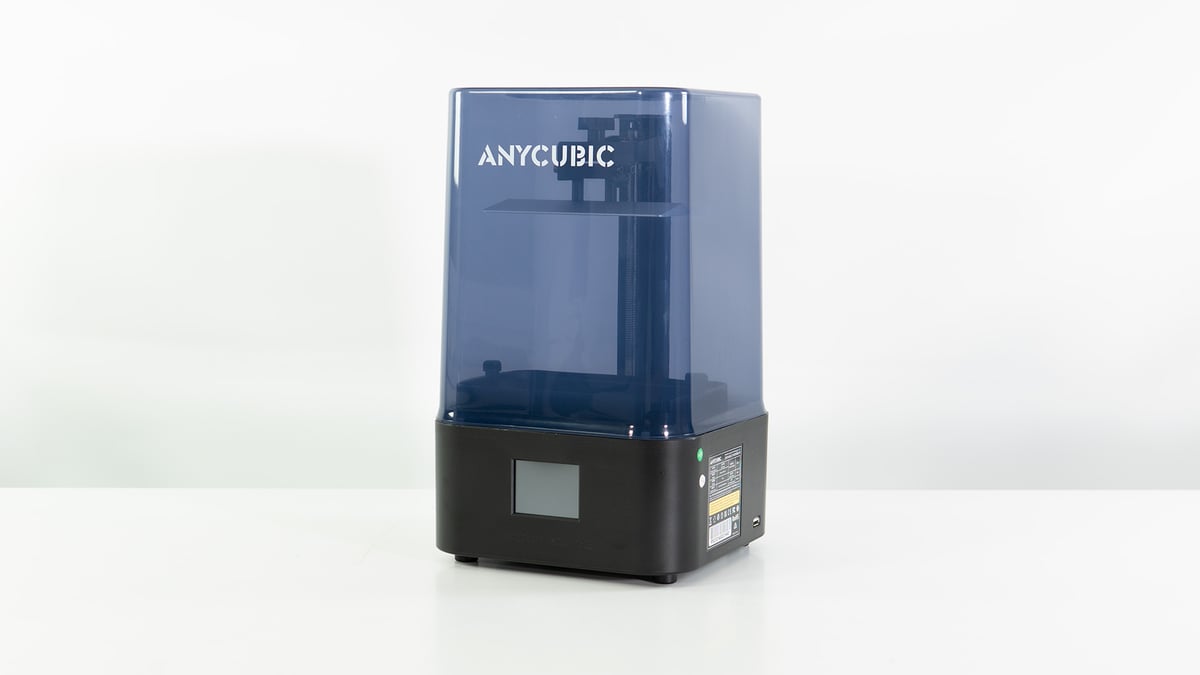
What’s Great
- High-resolution prints
- Deceptively large build volume
- Compact footprint
This ultra-budget resin 3D printer from Anycubic is a no-frills workhorse that’s simple to operate and reliably returns high-quality prints for your efforts. Easily found for ~$170, the bang you get for your buck is terrifically high; a 6-inch LCD is crammed inside the printer’s teeny footprint giving you a deceptively large 165 x 89 x 143 mm build volume to work with.
Interacting with the machine can be a bit fiddly, with the printer’s spartan exterior interrupted only by the 2.8-inch touchscreen front and center and a full-size USB port on the side. The Mono 2 is noticeably light, meaning any knocks and bumps resulting from interacting with it can tip it – not a desirable trait for a machine with a large, shallow pool of toxic resin inside.
Given the mess that resin 3D printing can make, Anycubic hedges things in your favor with a large screen protection kit included in the box. This guards the fragile LCD mask against resin spills, helping you eke out the full lifespan of the LCD before replacement is necessary.
Software-wise, the slicer Anycubic provides is decent enough for general printing with all essential preparation tools, including hollowing and hole punching, available to you out of the box. The Mono 2 is also compatible with third-party slicers, so you can use it with your preferred software instead.
Lightness and “eh” display aside (we can’t begrudge that last one much at this price point), the Photon Mono 2 is a comfortable budget pick.

Small (Resin):
Elegoo Mars 4 Ultra

What’s Great
- Super duper high-resolution prints
- Wi-Fi connectivity
- Refined software experience
Bucking the trend of mid-size printers getting better features and resolution these days, the Elegoo Mars 4 Ultra is a bolt from the blue, boasting one of, if not the highest resolution LCDs going in desktop resin 3D printing. It’s the best Mars series 3D printer to date, introducing a discerning pixel count that could see your models with voxels as fine as 18 microns in the X and Y- axes, resin and conditions dependent, of course.
Backing up the jump to such pixelatious new heights is a jump to a new OS for the printer. Based on Linux and exclusive to Elegoo’s new Ultra designation of printer, this new system layers in smarter features such as printer self-checks, richer print diagnostics, and the ability to adjust more print settings mid-print. When tested, we found the printer unable to check for OTA updates, despite the menu option to do so.
Minor gripes aside, it’s the typical workhorse performance we expect of Elegoo’s Mars series, but better.
Print performance is characteristically terrific, although the legwork typically required to dial in settings is still required here. There are no new systems or magic tools to make printing easier. It’s the same old tool, just a little sharper. And for ~$300, we absolutely do not mind. Elegoo has found some secret sauce to make their machines, with older (but still excellent) printers now dirt cheap and the new flagships at uber-competitive price points like this. We do not mind.
Alternatives
If you can do without the conveniences of Wi-Fi and uber-high resolution and want to spend as little as possible, then the Elegoo Mars 3 is the small printer to beat. Currently available for ~$150, you get a popular resin 3D printer that gives crisp, high-resolution prints and a year’s access to the Chitubox Pro slicer.
We struggled to think of any small desktop resin 3D printers that presented any kind of upgrade on the Mars 4 Ultra. With this in mind, we think the only direction to go is slightly larger, with a compact, mid-size resin 3D printer. Check our mid-size pick, the Anycubic Photon Mono M5s.

Mid-Size (Resin):
Anycubic Photon Mono M5s

What’s Great
- Capable of fast, high-res printing
- Resin level & print failure smarts
- Well-implemented Wi-Fi connectivity
The Anycubic Photon Mono M5s appears elsewhere on this list, both as our resin 3D printer under $500 pick and beginner’s pick. If that doesn’t say enough, then let’s recap. It is a mid-size build volume 3D printer, with an admittedly below-average build height – 218 mm compared to the Saturn 3’s 250 mm. It is, nevertheless, within our definition of being between 8-12 inches on the diagonal across the build volume.
You get a 12K masking LCD, giving it one of the finest resolutions available today, and, paired with a fast resin, the ability to print exceedingly fast. At full clip, you can print a full-volume print in a matter of a few hours.
The standout element of the M5s is its print plate sensor, which serves multiple purposes. For starters, it replaces the Z-axis endstop and, basically, gives ersatz plate leveling (you don’t need to do it, ever). Then there’s resin level measurement, to the degree the printer will tell you if it doesn’t think you have enough in the tank for your print. Finally, it has peel separation detection, which will alert you to the absence of the expected snapback jolt of the print separating from the resin vat release film. Without this, it’s safe to assume the print has failed, and the printer will pause itself for you to confirm and then cancel the print.
We’ll admit the system wasn’t 100% perfect in our time testing, but for the hit rate it does offer, it’s a welcome development on the desktop resin 3D printer and a feature-rich mid-size pick.
Alternatives
If you have a tighter budget to work with, the new Elegoo Saturn 3 offers all the resolution of the M5s and steady, reliable performance for a touch less at ~$380. You forego the connectivity and smart stuff, but as a basic tool to get the job done, it’s a fine option.
Alternatively, if you’ve got upgrade money budgeted for your mid-size resin 3D printer, then the UniFormation GKtwo calls. The screwless print plate and resin vat fixtures are ergonomic highlights alongside the flip-top lid. Best of all, though, is the heated resin vat, which gives near-guaranteed print success. It costs ~$850 but is easily the most luxurious resin printer we’ve used lately.

Learn more
Large-Format (Resin):
Phrozen Sonic Mega 8K S
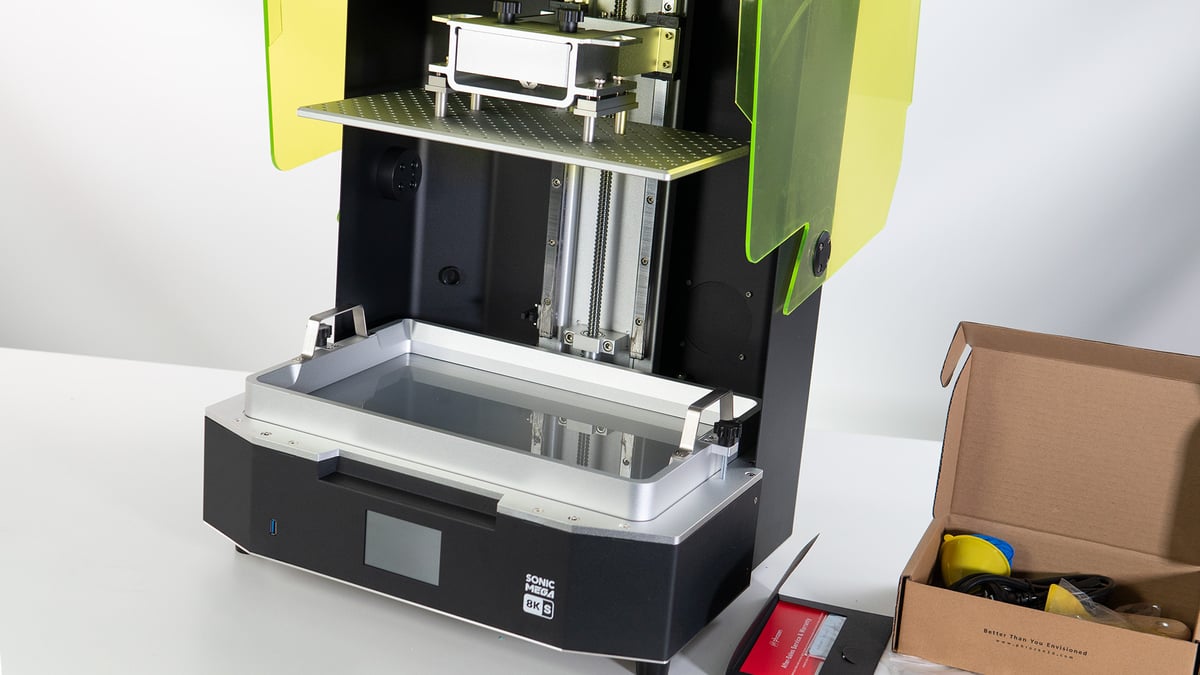
What’s Great
- User-friendliest design we’ve seen on a large desktop resin printer
- You can print single-piece helmets and larger objects
- The factory-leveled print plate makes your first print a cinch
Resin 3D printing is messy. With huge print plates and resin vats that need two-handed operation, large-format resin 3D printing has the potential to be even messier. The Phrozen Sonic Mega 8K S goes a merciful way to make this mess manageable with a user-friendly design and pre-calibrated build plate providing a ready-to-run experience right out of the box.
The Sonic Mega 8K S sports a flip-hinged lid that sweeps atop the printer, replacing the original Mega 8K’s double doors that spread wide to take up an enormous footprint. This helps the Mega 8K S keep a surprisingly compact footprint for its 330 x 185 x 300 mm print volume.
ACF film comes as standard on the Sonic Mega 8K S’ resin vat, which allows you to print fast at the expense of shortening the film and LCD’s lifespans. What fast means in this context is the transition speeds between layers, having the printer’s stages of movement happen quickly without putting stress on the print and putting it at risk of ripping apart.
Post-print, there’s a conveniently placed hook to hang the print plate from to let resin run back into the vat before you whisk the print away for cleaning.
In all, it’s an easy-to-handle large-format resin 3D printer that’s highly convenient for large jobs.
Alternatives
A budget alternative to consider is the Anycubic Photon M3 Max. At $799, it has enough of the ingredients for a comfortable and convenient printing experience, including an auto-resin refilling function that keeps your vat topped up for larger print jobs. The build volume is smaller, mind, and across this smaller volume, you have marginally less resolution to play with in your prints. It’s an excellent choice for half the money.
The Sonic Mega 8K S is a large machine, no doubt about it. But there are bigger resin 3D printers if you need to print huge, no matter the cost. The Peopoly Phenom XXL V2 is one such behemoth. It costs an eye-watering $8,199 but eclipses all others with its 527 × 296 x 550 mm build volume.
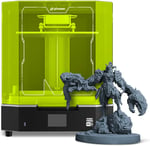
Beginners (Resin):
Anycubic Photon Mono M5s

What’s Great
- Capable of fast, high-res printing
- Resin level & print failure smarts
- Well-implemented Wi-Fi connectivity
There are a few ways we think a decent 3D printer for a beginner can go: either as a kit that’s as much an education as it is a purchased product; a simple, low-to-no-frill budget device that’s well-known and well-supported; or a rich, plug-and-play experience that gets on with the job better than the alternatives.
Currently, the Anycubic Photon Mono M5s is very much top of the plug-and-play pot, with its compact footprint offering a generous mid-size build volume and layer upon layer of smart, well-implemented features that make using the printer as smooth and hiccup-free as you could hope.
Chief among these things is the print-plate sensor, which brings a handful of benefits, including a leveling-free operation, resin fill level detection, and print failure detection. These three things are virtually unheard of in budget resin 3D printing, and all feature in the M5s.
The hit rate is not 100% perfect, granted – we didn’t see 100% success with the print failure detection – but even some failed prints caught (and subsequently paused by the printer) equal time and, potentially, resin saved. It makes for a pretty forgiving printer.
Rounding things off is fast and smooth Wi-Fi connectivity and a slick app experience that gives you a quick view of the printer’s condition, task list, and troubleshooting help should something go wrong.
Alternatives
The Elegoo Mars 3 is a safe bet for tighter budgets. It’s simple and easy to use, and we found it relatively forgiving in testing. There is a steep curve to resin 3D printing, but the Mars 3 is an easygoing companion to learn it with. Not to mention, it’s very cheap now – about $150 – and has been a popular model for a couple of years. There’s plenty of chatter online to turn to should you need it.
Alternatively, there is the UniFormation GKtwo. While it costs ~$850 – much more than our other beginner recommendations – it packs features like active resin vat heating, which virtually guarantees print success. Temperature is possibly the most significant factor in getting resin prints to succeed, and the GKtwo covers it completely. Add to this intelligent design touches that make interacting with the printer easier than all others, and it’s a worthwhile upgrade.

Learn more
What's Changed?
To help you keep track of past recommendations and structural changes to what we’re testing, here’s a changelog of what’s happened to this article in the last 12 months:
Update – March 14, 2024: This update brings the guide up to speed with recent changes to our budget, dual-extrusion, and large-format resin 3D printer guides.
Update – January 19, 2024: The end of 2023 and the beginning of 2024 saw the All3DP testing team hands-on with the Creality Ender 3 V3 SE and the Bambu Lab A1. Both of them are brilliant and are our new best 3D printer picks under $200 and $500, respectively.
Update – December 8, 2023: Price updates, minor edits for flow, and, in much more interesting news, some new recommendations. We have new medium-format picks, with Qidi Tech bursting onto the scene with its new X-series machines. Also, Bambu Lab’s A1 Mini is a solid new pick for beginners, and we have two new guides to add to the mix, with all new recommendations for enclosed 3D printers and toy 3D printers.
Update – November 10, 2023: Price changes see a number of our recommendations change places. That, and a handful of new additions, including the Bambu Lab P1S, Elegoo Mars 4 Ultra, Creality K1, and Comgrow T500, enter our guide.
Update – September 13, 2023: A minor update to correct prices to today’s value, plus a sentence tweak here and there.
Update – August 11, 2023: This year has seen a fair few changes to resin 3D printers, and this guide needed something of an overhaul. The Elegoo Mars 3, at its new reduced price, has slid over from our under $300 pick to take the take of its predecessor, the Elegoo Mars 2, as our under $200 pick. Replacing the $300 spot is the Creality Halot-One Plus, whose variant – the Halot-One Pro – previously held our $500 spot but has been overtaken by the Elegoo Saturn 3. The Anycubic Photon Mono M5s has dethroned the Phrozen Sonic Mini 8K for our $1,000 pick. Also new in resin 3D printing is our addition of a “small” category, charting the best printers with build areas under 8 inches across their diagonal.
Additionally, the Photon Mono M5s also takes gongs as our preferred mid-size resin printer and resin 3D printer for beginners.
We have new budget and upgrade picks for most resin categories, too.
Update – May 09, 2023: We’ve updated our “upgrade” recommendation for dual extrusion 3D printers (the excellent Bambu Lab P1P with AMS replacing the Tenlog TL-D3 Pro), plus other minor changes, including prices.
Update – April 07, 2023: We’ve been hands-on with the Snapmaker Artisan, and its improvements see it bump the Snapmaker 2.0 as our recommendation for 3-in-1 3D printer, laser and CNC machine. Also, we have a new mid-size filament 3D printer pick, the Sovol SV06 Plus, as a consequence of a new guide of ours to provide better coverage of 3D printers with the ~300 x 300 mm build areas.
Further updates include the Bambu Lab P1P as our upgrade pick for beginners, plus minor edits for correctness and flow. There are a lot of sales right now, so all prices have been updated, too.
How We Test
If there’s one thing that testing a lot of 3D printers has taught us, it’s that maintaining a broad benchmarking scheme for 3D printers is impractical for getting a sense of what a 3D printer is like to use and live with. Holding a sub-$200 self-assembled printer for hobbyists to the standard of a $6,000 production machine designed to handle engineering-grade materials won’t tell you that the former is a breeze to set up and the latter a tangled web of firmware updates, buggy systems, and unreliable performance.
We want our reviews and buyer’s guides to cut straight to the chase. What is it like to use a printer? What are the defining features like? What didn’t we like? And, more importantly, is it worth the money? We don’t want to get bogged down benchmarking numbers out of context or hung up on issues affected by more variables than we can control.
Who Are We Testing For?
Our buyer’s guides and reviews take the intended end user of a 3D printer into consideration. We imagine what they’re likely to do with it and focus the testing on challenging this. If we have a large-volume printer, for example, we’ll be printing – surprise, surprise – large prints, making use of the entire bed, and checking the performance at the limits of Z-height.
Other points of consideration for what makes the best 3D printer include ease of use, supporting software, and repair options. If something goes wrong, how easy is it to fix the machine? Does the documentation or customer service provide adequate information?
We strive to answer all these questions and more in our quest to find the best 3D printer for you.
Why Should You Trust Us?
Trust is important to All3DP, so our product testing policy is strict. When sourcing test units from a manufacturer, we do so under a zero guarantees policy. We make no guarantee of coverage in exchange for the printer, and the first time a manufacturer sees what we think is when we publish the content.
If a manufacturer doesn’t reclaim the unit after testing is complete, it is donated to a local cause or goes into deep storage for responsible disposal later. We occasionally buy machines for testing, too. In such cases, machines purchased by All3DP either remain in the office for team usage or are donated or disposed of in the manner described above.
Manufacturers or benefactors donating units for review do not influence the outcome or content of the reviews we produce. To the best of our ability, we will investigate abnormal issues with the manufacturer to glean better context or get insight into their awareness of the problem. But we make no excuses for poor design or bad QA.
How We Monetize Our Content
One method we monetize our content at no additional cost to the reader is through affiliate product links. If you click on a shopping link featured in our buyer’s guides and reviews, we may receive a small commission from the store if make a purchase. This is at no additional cost to you. For more meaty content policy details, we cover it all in the advertising and commercial activities section of our terms of use.
Which 3D Printer is Best for Me?
For most readers, our top recommended 3D printers are your best bet in a given category.
But, facing the fact that there is no one-size-fits-all solution to home 3D printing, we’re here to help. Here are some pointers to orient you in this terminologically dense but wonderful world. (A word on terminology, we have a handy glossary of terms to know at to bottom of this article.)
Beginner’s printers
Many 3D printers pitched for “beginners” or children go to such lengths to baby the user that they quickly become claustrophobic experiences. You will encounter more limitations than possibilities as your experience grows. If you aren’t satisfied with a “beginner” 3D printer’s features, we’d recommend a budget pick instead. You’ll save a little money, and the opportunity to learn by doing is far greater. And if something goes wrong, there are giant tribes online for each printer that have already asked and answered every question under the sun.
Follow the crowd
While the general quality of budget 3D printers has dramatically improved in recent years, quality control is often lacking. While manufacturers with large user bases are adapting to meet the demands of their newfound fans, including better customer support, there are usually better wells of knowledge to be found in the owners themselves, who contribute to the vast forum knowledge bases for some 3D printers.
Reviews matter
We have zero obligation to manufacturers to sugarcoat what we find, and the first time they read it is when you do too. That’s why you can trust our reviews. We don’t pander to anyone, and our experience with the printer is what you read on the page.
If you can’t find any information about a printer you’d like to know more about, let us know at editors@all3dp.com.
Understand the costs
A 3D printer for the home is rarely ever a one-and-done investment. Besides the continual purchase of materials, maintenance costs on perishable printer parts can stack up – think nozzles on an FDM printer or FEP film on an MSLA machine. Of course, parts can wear down or break, too, meaning sourcing replacement parts is a sensible consideration if you plan to print long-term. Printers with roots in the RepRap movement and open-source designs will be easiest to source parts for, with off-the-shelf components part and parcel of the design ethos behind them. Enclosed-design printers aimed at beginners may offer the gentlest introduction to printing, but your options to source spare parts will often be limited to the manufacturer. That’s if you can even get to and diagnose the problem.
Know why you want to 3D print
The thrill of a new hobby will only sustain you so far. Being the desktopification of an otherwise complicated manufacturing process, expect to encounter, sooner or later, problems with a home 3D printer – even the occasional show-stopping issue. Having an end goal in mind for your printing gives you purpose and a reason to learn the solutions to the problems. Printing simply because it looks cool will result in a small mountain of useless doodads and, eventually, disinterest at the hands of cost, frustration, and the buildup of useless plastic trash.
When you do know, pick a printer that will make it easier
Most home 3D printers are single extrusion fused deposition modeling machines, meaning a single printable material extruded through a single nozzle. Versatile enough for many applications through material compatibility, they’re safe machines to start with. But if you know you need to print objects with challenging geometries or semi-enclosed volumes, a dual extrusion printer would make your printing far easier. Likewise, single objects that need to have different material properties will only be achievable with dual extrusion. A resin printer will be the way to go for high-detail miniatures. Understand the technologies to find a printer that best suits your needs.
Pick a printer appropriate for your space
While the size of FDM 3D printers can vary greatly, the spillover is small. You’ll get some emissions from the filament melting, cloying the air, making it inadvisable to spend prolonged periods nearby. Generally speaking, the cleanup is minor and relatively easy to contain, depending on the models you print.
Resin 3D printing, however, is dramatically different and has unique demands that should make you think twice before investing. To varying degrees, the resin is smelly and toxic to you and the environment. It requires dedicated cleanup stations and personal protective equipment. You typically need 95 %+ isopropanol to clean prints and dissolve uncured resin from surfaces.
All printers should be operated in well-ventilated spaces, but this applies doubly to resin 3D printers.
Kickstarter – It’s complicated
While many excellent 3D printers have gotten their big break on Kickstarter, there’s the unavoidable issue that the platform is not a store. You are not buying a printer when you commit money to a campaign on Kickstarter; you are backing a vision. It’s putting money into the pot to help a company or person trying to achieve something.
You get nothing in return if a project is grossly mishandled and the money disappears. Often what you do get is the beta version of the product. You are paying for early access and all the wrinkles across all stages of the product that come with it.
We’re seeing more big-name companies turning to Kickstarter than ever to launch their products – it’s a safe way for them to gauge demand and drum up some interest against the pressure of a ticking countdown. Despite many companies being capable of outright launching products, they go cap-in-hand to enthusiasts with the promise of shiny new tech. Don’t be that user unless you absolutely must be the first to use a product and have money you can afford to lose.
We don’t think it’s worth the risk, but in the interest of cool new tech, report on new campaigns with our news coverage. You will never see a Kickstarter 3D printer in our buyer’s guides unless it has completed its campaign and the printer is widely available at retail, with all the protections that come with buying from a store.
Best Professional 3D Printers
But where’s the UltiMaker? Or Formlabs? What about Raise3D? Desktop Metal?
In the past, we’d list the best professional 3D printers alongside what we consider consumer or hobby-oriented machines (the printers we mainly focus on). An apples and oranges comparison, we know.
With this in mind, we created All3DP Pro, a wing of our content exclusively covering the professional applications of 3D printing and additive manufacturing solutions. Here’s a selection of articles covering the best 3D printers for professional use to get you started.
- The Best Professional 3D Printers Under $10,000
- The Best 3D Printers for Small Businesses
- The Best Metal 3D Printers in 2024
- The Best Carbon Fiber 3D Printers in 2024
- The Best Industrial Carbon Fiber 3D Printers
- The Best SLS 3D Printers in 2024
- The Best Independent Dual Extruder (IDEX) 3D Printers
- The Best Ceramic / Pottery 3D Printers in 2024
- The Best Dental 3D Printers of 2023
- PEEK 3D Printing – The Ultimate Guide
Glossary of Terms
Choosing the best 3D printer is tricky, not least because the terminology surrounding 3D printing is dense. Here are some need-to-know terms, their explanations, and useful links to help you on your way to 3D printing mastery.
FDM: Fused deposition modeling, otherwise known as FDM, is a 3D printing process that extrudes heated thermoplastic material through a moving nozzle to build an object layer by layer. FDM is a trademarked term, which led to the RepRap open-source movement to coin the alternative phrase “fused filament fabrication” (FFF), but the two are interchangeable.
Filament: Filament is the base material used to 3D print objects via FDM. The filament is typically a solid thermoplastic fed to a print head, heated to its melting point, and extruded through a small nozzle. Filament is commonly available in spools of either 1.75 mm, 2.85 mm, or 3 mm diameter widths – dimensions that dictate the printers that can use them.
G-Code: G-code is the machine language used to instruct computerized tools such as 3D printers. Giving coordinates and instructions for tool heads and other non-movement functions, it is almost exclusively generated by slicing software. It comprises a library of commands to control specific actions like motion, speed, rotation, depth, and other related switches and sensors used in a machine’s operation. You can get to grips with G-code in no time with our guide to G-code commands.
Heated bed: This is a build plate that is heated so that the few layers of extruded plastic are prevented from cooling too quickly and then warping. A heated bed is essential for working with ABS or PETG materials but not so much with PLA.
Hot end: This is the cluster of components that heat and melt the plastic for deposition through the nozzle.
Extruder: Used by some to describe the entire system of parts that pushes and melts filament, extruder can also refer specifically to the motor and accompanying gears that grip the filament, feeding it to the hot end. How the extruder is arranged can affect the printer and its capabilities. There are two common arrangements: Bowden and direct. It’s a messy subject with overlapping terms and technical explanations; our guide to 3D printer extruders gives you all the knowledge to make sense of it.
Bowden: A style of extruder that sees the extruder motor positioned away from the hot end – typically the structural frame of the printer or on one end of the X-axis gantry. So-called for the Bowden cable and its action of allowing a wire to move freely within tightly constraining tubing, the Bowden extruder feeds filament through a PTFE tube directly into the hot end.
Direct Extruder: The other commonly seen extruder type, a direct extruder sees the extruder motor and associated feeding mechanism mounted directly to the hot end, with barely any distance between the feed and the melt zone of the hot end.
Dual Extrusion: Some 3D printers carry two extruders/hot ends, allowing them to incorporate multiple colors or materials into the same print job. While the obvious appeal comes from the possibility for decorative two-tone prints, the real benefit of dual extrusion systems is combining different materials, such as dissolvable support material, to enable the printing of otherwise impossible geometries. It’s a deep topic worth exploring more in our guide to all you need to know about dual extrusion.
PLA: Polylactic Acid, otherwise known as PLA, is a thermoplastic commonly used as a material for printing with FDM 3D printers. It’s easy to work with and is available in many colors and finishes. PLA is somewhat brittle – don’t expect to print strong items with it – but it remains popular for decorative printing thanks to its low cost. You can learn more about PLA in our guide dedicated to the topic.
SLA: Stereolithography is a 3D printing technology that falls under the broader process of vat photopolymerization. The term is often (incorrectly) used to describe all methods of vat polymerization – really, it’s a particular technology that uses a directed laser beam to trace layers into a vat of liquid photopolymer resin. Alongside SLA, other technologies are considered vat polymerization.
Resin: The material used in desktop SLA, DLP, and LCD (MSLA) 3D printers. A blend of chemicals that includes a photoinitiator, resin solidifies under ultraviolet light. Highly toxic and difficult to clean up after a spill, care, attention, and personal protective equipment are musts when working with resin. It is an unpleasant material, and wastage must be disposed of in accordance with local laws. Despite all the warnings, it’s the only way to go for intricate detail.
LCD 3D Printer: A common term for resin 3D printers that use an LCD as a layer mask over UV light. The de facto standard in inexpensive resin 3D printers, the technology is cheap and widely used. The LCD panels are consumable, though, with monochrome LCDs typically having lifespans in the low 1,000s of hours.
MSLA: Mask stereolithography (MSLA) is a term coined by Structo but popularized by Prusa Research. It refers to, basically, the LCD 3D printer as described above.
Micron: One-thousandth of a millimeter. This unit of measurement is commonly used in 3D printing as a value to indicate accuracy, resolution, or surface finish.
Slicer: 3D printing works by building an object layer by layer. A slicer is a program that divides a 3D model into flat layers and generates the machine code for the printer to trace out said layers. The output of a slicer for FDM 3D printers is typically G-code, which gives instructions and coordinates for the printer to execute. Our deep dive explaining what exactly a slicer is gives good foundational knowledge. Many popular slicers are free and open source. Others are proprietary and machine-specific. It’s an essential tool for successful 3D printing.
STL: STL is the most popular file format for 3D printing. Developed by 3D Systems in the ’80s, the STL file type only contains the surface geometry of a 3D object. Despite industry efforts to move onto more efficient and data-rich formats such as 3mf, STL endures and is the most commonly found 3D model file type on popular 3D model file repositories. We explain in more detail in our guide to what exactly STL is.
Open Source: The term given to a product, typically software, but also applicable to hardware that is freely open for others to modify and redistribute according to their needs. In 3D printing, this is often in the spirit that individuals are free to modify, improve, and share changes to the source material for others to test, iterate, and reciprocate. Open source licenses govern the fair and correct usage of open source works, giving terms and conditions that ensure the freedom of access to the creation and any derivatives.
RepRap: A project started in 2005 by Dr. Adrian Bowyer, a mechanical engineering lecturer at the University of Bath. Created to develop a replicating rapid prototype, a low-cost machine capable of printing replacement parts for itself or other new machines. The vast majority of desktop 3D printers stem from the work laid down by the RepRap project. We have a fascinating alternative RepRap Wiki page on the topic if you want to dig deeper.
License: The text of "The Best 3D Printers in 2024 – Buyer’s Guide" by All3DP is licensed under a Creative Commons Attribution 4.0 International License.
CERTAIN CONTENT THAT APPEARS ON THIS SITE COMES FROM AMAZON. THIS CONTENT IS PROVIDED ‘AS IS’ AND IS SUBJECT TO CHANGE OR REMOVAL AT ANY TIME.

 Stay Informed, Save Big, Make More
Stay Informed, Save Big, Make More





















